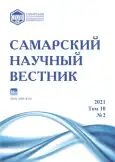The state of the adaptive potential of Quercus robur L. in field-protective forest belts based on the study of substances of secondary metabolism
- Authors: Sautkina M.Y.1
-
Affiliations:
- All-Russian Research Institute of Forest Genetics, Breeding and Biotechnology
- Issue: Vol 10, No 2 (2021)
- Pages: 86-89
- Section: General Biology
- URL: https://journals.rcsi.science/2309-4370/article/view/78100
- DOI: https://doi.org/10.17816/snv2021102112
- ID: 78100
Cite item
Full Text
Abstract
The paper studies various groups of substances of secondary metabolism of phenolic nature in the leaves of model trees of English oak growing in the field-protective forest belts of the agroforestry complex «Kamennaya Steppe». A physiological and biochemical analysis was carried out on samples of oak leaves from each tree in two stages – in the first decade of June and in early August. From each model tree 4–6 shoots of the lower tier of the southern exposure were selected. Significant biochemical diversity of the control and experimental groups of model oak trees was revealed. It is shown that the most significant fluctuations in the level of phenolic substances occur at the beginning of the growing season and then their content is stabilized. The informativeness of biochemical monitoring studies in the complex assessment of the current state of oak stands was confirmed. It is proved that the content of substances of secondary metabolism of phenolic nature and their combination can serve as a criterion of potential energy efficiency.
Full Text
##article.viewOnOriginalSite##About the authors
Marina Yurievna Sautkina
All-Russian Research Institute of Forest Genetics, Breeding and Biotechnology
Author for correspondence.
Email: sautmar@mail.ru
candidate of agricultural sciences, researcher of Ecological Genetics Laboratory
Russian Federation, VoronezhReferences
- Федотов В.И. Антропогенез – объективная реальность в географической оболочке Земли // Вестник ВГУ Сер. География. Геоэкология. 2014. № 3. С. 5–8.
- Haviola S., Saloniemi J., Ossypov V. et al. Additive genetic variation of secondary and primary metabolites in mountain birch // OIKOS. 2006. № 112. P. 382–391.
- Киракосян Р.Н., Калашникова Е.А. Содержание фенольных соединений в листьях растений-регенерантов капусты белокочанной (Brassica oleracea L.) // Известия Тимирязевской сельскохозяйственной академии. 2017. № 2. С. 34–42.
- Сауткина М.Ю., Кузнецова Н.Ф., Тунякин В.Д. Современное состояние полезащитных лесных полос с преобладанием дуба черешчатого (Quercus robur L.) // Лесохозяйственная информация. 2018. № 1. С. 78–89.
- Беликов В.В. Оценка содержания флавонол-производных в плодах Sylabium marianum (L.) // Растительные ресурсы. 1985. № 3. С. 350–358.
- Julkunen-Titto R. Phenolic constituents in leaves of northen willows: methods for the analysis of certain phenolics // Journal of Agricultural and Food Chemistry. 1985. № 33. P. 213–217.
- Харборн Дж. Биохимия фенольных соединений. М.: Изд-во «Мир», 1968. 448 с.
- Salminen J.-P., Roslin T., Karonen M. Seasonal variation in the content of hydrolizable tannins, flavonoid glycosides and proanthocyanidins in oak leaves // Journal of Chemical Ecology. 2004. № 30 (9). P. 1693–1702.
- Полякова Л.В. Фенольные соединения листьев материнских деревьев и сеянцев полусибсового потомства дуба черешчатого // Биологический вестник. 2007. № 11. С. 61–66.
- Agati G., Azzarello E., Pollastri S., Tattini M. Flavanoids an antioxidants in plants: Location and functional significance // Plant Science. 2012. № 196. P. 67–76.
- Lahtinen M., Kapari L., Ossipov V., et al. Biochemical transformation of birch leaf phenolics in larvae of six species of sawflies // Chemoecology. 2005. № 1 (3). P. 153–159.
- Полякова Л.В., Литвиненко В.И. Регуляция синтеза некоторых групп фенольных соединений в листьях дуба черешчатого в условиях повреждения патогенной инфекцией и насекомыми // Фенольные соединения: фундаментальные и прикладные аспекты: сб. науч. тр. М., 2015. С. 396–403.
- Полякова Л.В., Литвиненко В.И. Значение вторичных метаболитов в формировании устойчивости к мучнистой росе деревьев 16-летних культур дуба черешчатого // Лесоведение. 2019. № 2. С. 128–137.
- Полякова Л.В., Литвиненко В.И. Биохимическое разнообразие полусибсового потомства деревьев дуба черешчатого как источник отбора генотипов для микроклонирования // Бюллетень ГНБС. 2016. № 121. С. 24–32.
- Ossipov V., Salminen J.-P., Ossipova S., Haukioja E., Pihlaja K. Gallic acid and hydrolysable tannins are formed in birch leaves from an intermediate compound of the shikimate pathway // Biochemical Systematics and Ecology. 2003. № 31 (1). P. 3–16.
- Полякова Л.В. Сезонная изменчивость фенольных соединений в листьях деревьев дуба черешчатого (Quercus robur) и красного (Quercus rubra), устойчивых и восприимчивых к мучнистой росе (Microsphaera alphitoides) // Лiciвництво i агролiсомелiорацiя. 2008. № 113. С. 252–259.
- Шеин И.В., Шибистова О.Б., Зражевская Т.К., Астраханцева Н.Г., Полякова Г.Г. Содержание фенольных соединений и активность ключевых ферментов их синтеза в гипокотилях сосны обыкновенной при фузариозе // Физиология растений. 2003. № 50. С. 581–586.
- Полякова Л.В., Кузнецова Н.Ф. Повышение устойчивости лесозащитных полос с участием сосны обыкновенной на основе изучения особенностей метаболизма веществ вторичного обмена // Бюллетень ГНБС. 2020. № 136. С. 140–147.
Supplementary files








